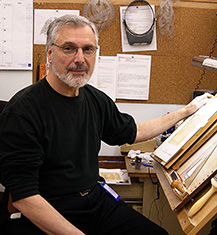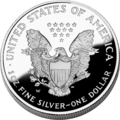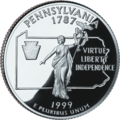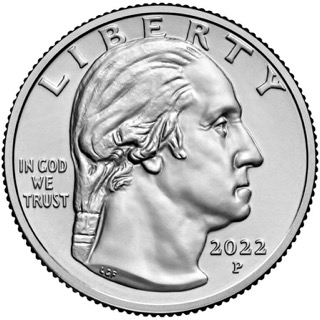
The quarter, short for quarter dollar, is a United States coin worth 25 cents, one-quarter of a dollar. The coin sports the profile of George Washington on its obverse, and after 1998 its reverse design has changed frequently. It has been produced on and off since 1796 and consistently since 1831.

The United States Mint is a bureau of the Department of the Treasury responsible for producing coinage for the United States to conduct its trade and commerce, as well as controlling the movement of bullion. The U.S. Mint is one of two U.S. agencies that produce money in the case of minting coinage; the other is the Bureau of Engraving and Printing, which prints paper currency. The first United States Mint was created in Philadelphia in 1792, and soon joined by other centers, whose coins were identified by their own mint marks. There are currently four active coin-producing mints: Philadelphia, Denver, San Francisco, and West Point.

The dime, in United States usage, is a ten-cent coin, one tenth of a United States dollar, labeled formally as "one dime". The denomination was first authorized by the Coinage Act of 1792.
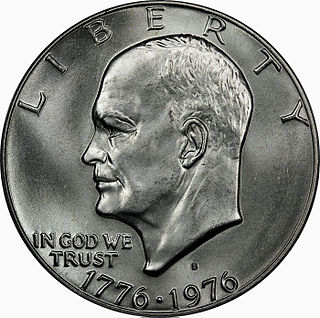
The United States Bicentennial coinage is a set of circulating commemorative coins, consisting of a quarter, half dollar and dollar struck by the United States Mint in 1975 and 1976. Regardless of when struck, each coin bears the double date 1776–1976 on the normal obverses for the Washington quarter, Kennedy half dollar and Eisenhower dollar. No coins dated 1975 of any of the three denominations were minted.

The Eisenhower Commemorative silver dollar is a United States commemorative coin minted in 1990 to celebrate the 100th Anniversary of the birth of General/President Dwight D. Eisenhower. This coin is not to be confused with the Eisenhower dollar or the Eisenhower Presidential dollar which were regular issue American coins.

The Walking Liberty half dollar is a silver 50-cent piece or half dollar coin that was issued by the United States Mint from 1916 to 1947; it was designed by Adolph A. Weinman, a well-known sculptor and engraver.

The Standing Liberty quarter is a 25-cent coin that was struck by the United States Mint from 1916 to 1930. It succeeded the Barber quarter, which had been minted since 1892. Featuring the goddess of Liberty on one side and an eagle in flight on the other, the coin was designed by American sculptor Hermon Atkins MacNeil.

Thomas D. Rogers, Sr. is a former sculptor-engraver with the United States Mint and designer of several U.S. coins, including the 2000–2008 reverse side of the United States Golden dollar coins, or Sacagawea dollars. Rogers holds an A.A.S. degree with a major in commercial art. He joined the U.S. Mint in October 1991, working at the Philadelphia Mint facility, and retired in 2001. As of 2003 he was residing in Long Beach, Washington, and as of 2009 he was living and working in Oregon. His design for the Sacagawea dollar was modified slightly before it went into circulation.
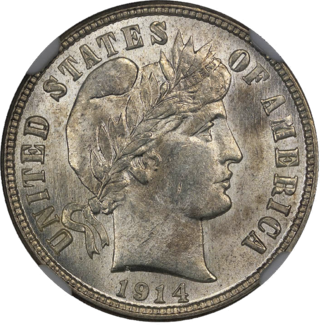
The Barber coinage consists of a dime, quarter, and half dollar designed by United States Bureau of the Mint Chief Engraver Charles E. Barber. They were minted between 1892 and 1916, though no half dollars were struck in the final year of the series.

The Isabella quarter or Columbian Exposition quarter was a United States commemorative coin struck in 1893. Congress authorized the piece at the request of the Board of Lady Managers of the World's Columbian Exposition. The quarter depicts the Spanish queen Isabella I of Castile, who sponsored Columbus's voyages to the New World. It was designed by Bureau of the Mint Chief Engraver Charles E. Barber, and is the only U.S. commemorative of that denomination that was not intended for circulation.

The Washington quarter is the present quarter dollar or 25-cent piece issued by the United States Mint. The coin was first struck in 1932; the original version was designed by sculptor John Flanagan.
Donald Nelson Everhart II is an American coin and medal engraver-medalist, and sculptor who has worked for the private Franklin Mint, as a freelance designer, and since 2004 has worked for the United States Mint in Philadelphia. With over 1,000 models for coins and medals attributed to him as of 2008, he is still at the prime of his career creating the bas-relief models for these and similar sculptural objects. His coin designs are in the pockets of American citizens, and despite his late arrival to the series of the popular U.S. Statehood Quarters, he has designed and modeled three State's unique reverse designs, modeled three others, and six U.S. commemorative coins. His portrait of President William Clinton was chosen for Clinton's second term Inaugural Medal. Among his other medal creations are six Congressional Gold Medals for the U.S. Mint, seven Society of Medalists issues, twelve calendar medals, and other models for private medal makers, as well as cast art medals.

The United States Sesquicentennial coin issue consisted of a commemorative half dollar and quarter eagle struck in 1926 at the Philadelphia Mint for the 150th anniversary of American independence. The obverse of the half dollar features portraits of the first president, George Washington, and the president in 1926, Calvin Coolidge, making it the only American coin to depict a president in his lifetime.

The five Panama–Pacific commemorative coins were produced in connection with the 1915 Panama–Pacific International Exposition in San Francisco. Struck at that city's mint, the issue included round and octagonal $50 pieces. Excepting modern bullion coins, these two gold pieces are the highest denomination ever issued and the largest coins ever struck by the United States Mint. The octagonal $50 piece is the only U.S. coin to be issued that is not round.

The Apollo 11 50th Anniversary commemorative coins were issued by the United States Mint in 2019 to commemorate the 50th anniversary of the first crewed landing on the Moon by Apollo 11 astronauts Neil Armstrong and Buzz Aldrin. Consisting of a gold half eagle, two different sizes of silver dollars, and a copper-nickel clad half dollar, each of the four was issued in proof condition, with all but the larger silver dollar also issued in uncirculated. The gold coins were struck at the West Point Mint, the silver at the Philadelphia Mint and the base metal half dollars at the mints in Denver and San Francisco.
The Leif Ericson Millennium commemorative coins are a series of coins issued in 2000 by the United States Mint to commemorate the 1,000th anniversary of Leif Ericson's discovery of the Americas.

Library of Congress silver dollar is a commemorative coin issued by the United States Mint in 2000. The coin was part of a two-coin series authorized by Pub. L.Tooltip Public Law 105–268 (text)(PDF) commemorating the 200th anniversary of the Library of Congress.
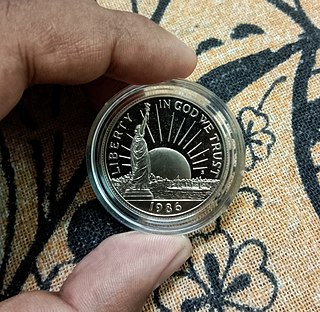
The Statue of Liberty commemorative coins are a series of commemorative coins which were issued by the United States Mint in 1986, the 100th anniversary of the dedication of the Statue of Liberty.
